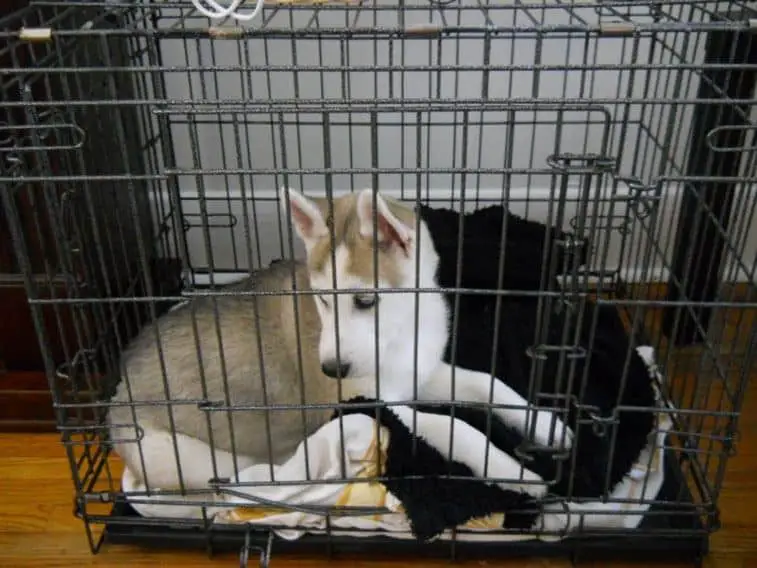Last Updated on 11/05/2020 by Veronica Jones
Potty training can be a challenging time for dog owners. Not only do you need to teach your dog how to not have accidents around your home, but to also refrain from going in their crate as well.
In this article, we’ll dive into the basics on how to stop your dog from peeing in their crate, and the steps you can implement for potty training success!
Consider Their Age
Before we jump into the potty training discussion, it’s important to rule out the possibility of this being due to a more serious cause. If your 3-month-old puppy is urinating in their crate, it’s more likely that this is a situation that will benefit from proper potty training. However, if your adult dog that has never had a problem with peeing in their cage is now suddenly struggling with holding it in their crate, this is something that should be brought to your vet’s attention.
Steps To Stop Your Dog From Peeing In Their Cage
When it comes to a dog that is urinating in their crate, there are many possible reasons behind the behavior. In order to help you better understand why your pup is struggling, let’s discuss each step you can follow to help them succeed.
Understand That Crate Size Is Important
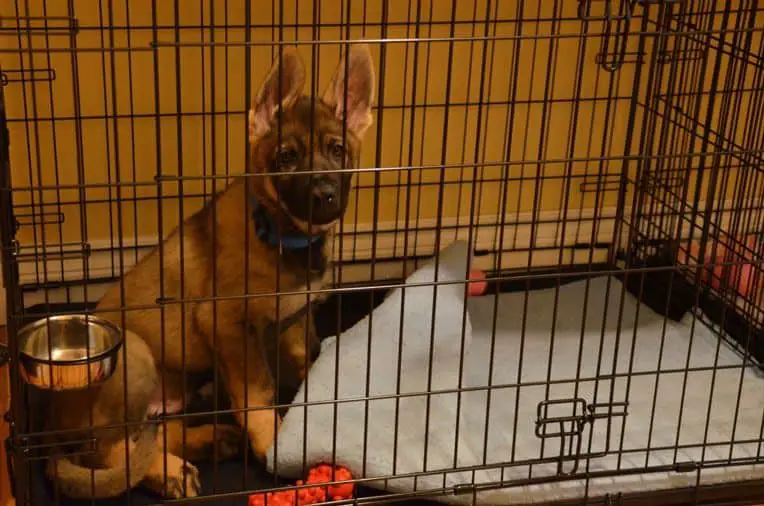
One of the most common reasons behind dogs having accidents in their crate is due to having a crate that is too large. When your pup is able to urinate in their cage and still have plenty of room to move away from the accident, they are more likely to feel comfortable with peeing in their crate. Dogs don’t typically enjoy laying near their urine, so a large cage gives them the freedom of moving away after they’ve done the deed!
I know we associate a bigger crate with optimal comfort for our furry friends, but that’s not the case. We can offer our dogs a cozy crate without all the extra space as long as we follow a few rules. First, make sure their crate is large enough for them to stand up with ease and without having to hunch over. Next, make sure they are able to turn around inside of their cage. Lastly, make sure your pup is able to lay down comfortably without being squished. As long as your dog can do all of these things, their cage is acceptable!
Are they going outside enough?
When you are trying to help your dog understand that they shouldn’t urinate in their crate, you will need to make sure that they have plenty of opportunities to go outside and go potty. They’ll need to make the connection between the outdoors being their urinating spot and their cage being a rest zone, and you will only be able to do this if you make it as easy as possible for them to grasp!
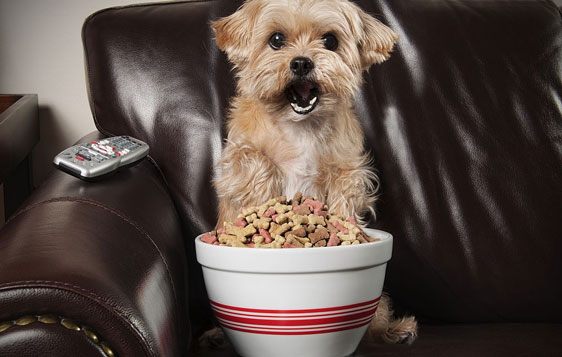
You can boost their success by offering them a tasty treat each time they pee outside, helping them to understand even more that this is a behavior that you want them to continue! As long as you make sure that your dog is going outside multiple times a day to pee (6-8 times during potty training), then you are already setting them up for crate training success.
How long are they left in the crate?
When it comes to helping our dogs understand that their crate is not for using the bathroom, we have to make sure that we have realistic expectations. Our dogs shouldn’t be expected to hold their urine for multiple hours on end, especially if they are new to potty training. Holding their urine for an extended period of time can be challenging for a young dog, and even uncomfortable if they are forced to wait too long.
When you are beginning the crate training process with your dog, make sure you are starting out slow. Start by keeping them in their crate for 2 hours, then 4 hours, then 6, and so on. After each of these time increments you will then take your pup outside to use the bathroom. By taking this slow you can help your dog understand that if they hold it, you will soon be there to let them out to relieve themselves.
Always Clean Up Thoroughly
Have you ever noticed that your pup gravitates toward the same spots in the yard when they use the bathroom? This is due to them smelling the scent of their urine and instinctually urinating in the same spot again. This is also why dogs tend to have accidents in the same spots within the house during their potty training process.
Because of this, it’s important to make sure you clean their cage thoroughly after each accident they have in their crate. This means washing any bedding they urinated on, cleaning the base of the cage, and doing your best to eliminate any odors left behind. By getting rid of any remnants of their last accident, you can help to prevent any accidents in the future!
Understand When To Take Away Water
Another extremely common reason behind dogs urinating in their crate is due to their unlimited access to water. I know we would like to give our pups some water to sip on throughout the night while they are in their cage, but this can lead to accidents in their crate if they have not yet mastered potty training.
If your dog drinks plenty of water throughout the day, they will be just fine without water in their cage overnight or for a few hours while you are away throughout the day. Dogs don’t understand that they need to limit their water intake in order to decrease their need to urinate, so it’s up to us to solve this problem for them.
If you are truly worried about not having any water in their crate, you can offer them a small amount to sip on as long as it’s not a full bowl. Preventing your pup from gulping down a bowl of water will only help them when it comes to having any accidents in their crate.
Understand Positive Potty Training
Your dog’s entire potty training routine will affect the way they behave in their crate. A dog that is receiving positive reinforcement style potty training will not only be well rounded in basic obedience, but will be more receptive to understanding crate training as well. You want your pup to view their cage as a place of comfort, and never a place that results in fear or punishment.
Though it can be frustrating to see that your dog had an accident in their crate, try not to punish them. It can be challenging for a dog to understand what exactly they did wrong inside of their crate, and may end up associating their crate with that punishment.
The best way to prevent future accidents is by promoting excitement with positive reinforcement. This means giving your dog a treat every time they urinate outside, offering them praise each time they don’t have an accident in their crate, and trying your best to make sure their crate is a comfort zone. When your pup knows that they will be rewarded each time they hold it and go potty outside, they will be more likely to repeat that desired behavior.
Rule Out A Behavioral Cause
Accidents in the crate are not always linked to the inability to hold their urine, but rather a behavioral issue at play. Some dogs truly struggle with being confined in a crate and away from their owner, and they respond by having accidents inside their cage. So how do you know if this is the case with your dog?
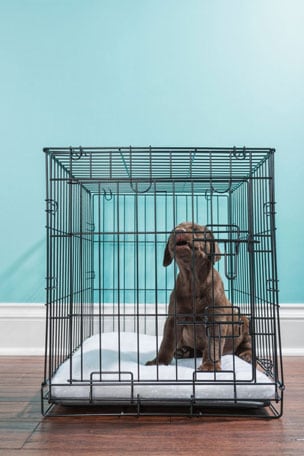
The best way to understand if your dog’s crate accidents are due to a behavioral issue is by assessing their other behaviors as well. If your dog is crying and howling when you put them in their crate, biting at the cage walls, pawing at the cage walls, and acting frantic while they are crated, you can assume that this may be due to separation or cage anxiety.
Since we are not always home once we put our furry friends in their crate, you can always videotape your pup in order to know what they are doing while you are away. By setting up a camera you can finally see how they behave once you step out your door, and hopefully have a better understanding of what could be causing these accidents.
Rule Out Urinary Issues
Like we briefly mentioned before, sometimes your dog’s accidents can point to a more serious issue. If your dog is suddenly having accidents in their crate or keeps having accidents no matter how many changes you implement, it’s best to visit your local veterinarian and rule out any urinary issues.
Urinary issues are fairly common in dogs and can result in them having a hard time holding it for an extended period of time. Common issues like urinary tract infections and kidney disease make your dog feel like they need to urinate more often, and will often lead to accidents in their crate. It can be truly painful to hold their bladders when they are experiencing these issues, so sometimes they have no other choice but to go.
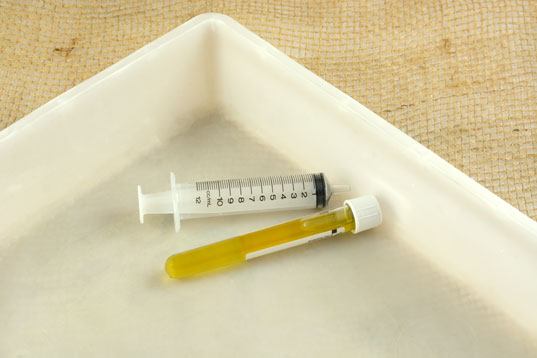
Your veterinarian will be able to rule out any urinary issues with a simple urine test that will search for any bacteria or crystals in the urine. If your dog does happen to have any signs of a UTI, they will likely send your pup home with a course of antibiotics to resolve the infection. Once you are able to resolve any urinary complications and get them back on track, your pup will have a shot at crate training success.
Other Options When You Are Away
If you have a dog that does not enjoy being in a crate and they have already mastered potty training, there are other ways to keep them confined. These options include:
- Keeping your pup in a play pen that gives them more room to roam. You can always lay down potty pads just in case to prevent your dog from having an accident on your floor.
- You can block off a small area in your home that your dog is allowed to roam freely while you are away. This can be in a bathroom, a hallway, a kitchen, or any other small area within your home.
- Consider hiring a dog walker to come to your house once while you are away for the day. This way your dog can roam your house freely and will be let outside during the day to go potty. This will prevent any accidents in your home.
Even with implementing each of the tips we’ve listed above, it can take your pup a bit of time to truly grasp the concept. Just make sure that you are being understanding of the fact that your pup is a work in progress, and that a positive attitude will help them achieve their crate training goals.

